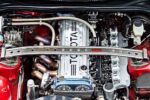Chevy 434 Engine: A Brief Overview
History and Background
The Chevy 434 engine, a popular choice among performance enthusiasts, is a product of the small-block Chevy lineage that has dominated the automotive scene for decades. This engine is essentially a modified version of the classic 350 cubic inch small-block, enhanced by a larger bore and stroke to achieve its 434 cubic inch displacement. The 434 engine is often built using aftermarket components, allowing for significant power gains and improved performance. It has become a staple in the hot rod community, favored for its balance of power and reliability.
The roots of the small-block Chevy can be traced back to the late 1950s when General Motors introduced the 283 cubic inch engine. Over the years, this engine evolved through various iterations, culminating in the 350, which became one of the most widely produced engines in automotive history. The 434 emerged as a natural progression for those seeking more power from their small-block setups, often used in racing applications and high-performance street cars.
While the Chevy 434 engine is celebrated for its potential to produce impressive horsepower and torque figures, it is not without its issues. Enthusiasts and builders have reported a range of problems that can arise during installation and operation. Understanding these potential pitfalls is crucial for anyone considering a build with this engine. From overheating to oiling issues, the 434 engine demands attention to detail and a solid understanding of its mechanics to ensure optimal performance and longevity. In the following sections, we will delve into the common problems associated with the Chevy 434 engine, providing insights for both current and prospective owners.
Common Issues with the Chevy 434 Engine
The Chevy 434 engine, while powerful and a favorite among performance enthusiasts, is not without its share of problems. Understanding these issues is essential for anyone looking to build or maintain a 434 engine. Below are some of the most common problems associated with this engine, along with their symptoms and potential consequences.
Overheating
One of the most frequently reported issues with the Chevy 434 engine is overheating. This can occur for several reasons:
- Insufficient cooling system capacity
- Improper radiator size or design
- Faulty thermostat or water pump
- Blocked coolant passages
Overheating can lead to severe engine damage, including warped cylinder heads and blown head gaskets. It’s crucial to monitor engine temperatures and ensure the cooling system is functioning correctly.
Oil Consumption
High oil consumption is another common problem with the 434 engine. This can be attributed to:
- Piston ring wear
- Valve seal failure
- Improper break-in procedures
Excessive oil consumption can result in poor engine performance and increased emissions. Regular oil checks and timely maintenance can help mitigate this issue.
Fuel Delivery Issues
Fuel delivery problems can significantly impact the performance of the Chevy 434 engine. Common causes include:
- Clogged fuel filters
- Faulty fuel pumps
- Improperly calibrated carburetors or fuel injectors
These issues can lead to poor acceleration, stalling, and overall lack of power. Ensuring the fuel system is clean and properly calibrated is essential for optimal performance.
Ignition Problems
Ignition system failures can also plague the Chevy 434 engine. Key factors include:
- Worn spark plugs
- Faulty ignition coils
- Poorly adjusted timing
Ignition issues can result in misfires, reduced power, and increased fuel consumption. Regular maintenance of the ignition system is vital to avoid these problems.
Common Symptoms and Consequences
To summarize the issues discussed, here’s a table outlining the symptoms and consequences of common Chevy 434 engine problems:
| Problem | Symptoms | Consequences |
|---|---|---|
| Overheating | High temperature readings, steam from engine | Warped heads, blown gaskets |
| Oil Consumption | Frequent oil top-ups, blue smoke from exhaust | Poor performance, increased emissions |
| Fuel Delivery Issues | Stalling, poor acceleration | Loss of power, potential engine damage |
| Ignition Problems | Misfires, rough idle | Increased fuel consumption, reduced power |
Understanding these common problems and their symptoms will help Chevy 434 engine owners maintain their engines effectively and avoid costly repairs. Regular maintenance and attention to detail are key to ensuring the longevity and performance of this powerful engine.




0 Comments